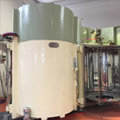Understanding Aluminum Mirror Lines: A Key Element in Architectural Design
Time:
2025-06-08 10:20
Aluminum mirror lines have gained significant attention in the architectural and decorative materials industry, particularly in the realm of building profiles and aluminum extrusions. These specialized components, characterized by their reflective surfaces and lightweight properties, serve both functional and aesthetic purposes in modern architecture.
One of the primary advantages of aluminum mirror lines is their ability to create an illusion of space and light. In interior design, these mirrors can be strategically placed to enhance natural light, making rooms appear larger and more open. This is particularly useful in smaller spaces where maximizing the perceived area is essential. Furthermore, the reflective quality of aluminum mirrors can add a touch of elegance and sophistication to any environment, making them a preferred choice among architects and designers.
In addition to their aesthetic benefits, aluminum mirror lines are highly durable and resistant to corrosion. Unlike traditional glass mirrors, aluminum mirrors can withstand environmental elements, making them suitable for both indoor and outdoor applications. This resilience ensures that the reflective quality remains intact over time, reducing the need for frequent replacements and maintenance. As a result, they are an excellent choice for various architectural applications, including facades, decorative panels, and functional elements in buildings.
Moreover, the sustainability aspect of aluminum mirror lines cannot be overlooked. Aluminum is a highly recyclable material, which aligns with the growing trend towards environmentally friendly construction practices. By incorporating aluminum mirrors into design projects, architects and builders can contribute to reduced waste and energy consumption, supporting a more sustainable future for the industry.
When considering the implementation of aluminum mirror lines in a project, it is crucial to choose the right type and finish for the intended application. Various treatments can enhance the reflective properties while providing additional benefits such as scratch resistance and UV protection. Consulting with experienced suppliers and manufacturers can help in selecting the most appropriate options tailored to specific project needs.
In conclusion, aluminum mirror lines are an invaluable asset in the fields of architecture and decorative materials. Their ability to blend functionality with aesthetic appeal makes them a versatile choice for contemporary design projects. By understanding the benefits and applications of aluminum mirror lines, clients can make informed decisions that enhance their architectural endeavors while promoting sustainability and innovation in building practices.
One of the primary advantages of aluminum mirror lines is their ability to create an illusion of space and light. In interior design, these mirrors can be strategically placed to enhance natural light, making rooms appear larger and more open. This is particularly useful in smaller spaces where maximizing the perceived area is essential. Furthermore, the reflective quality of aluminum mirrors can add a touch of elegance and sophistication to any environment, making them a preferred choice among architects and designers.
In addition to their aesthetic benefits, aluminum mirror lines are highly durable and resistant to corrosion. Unlike traditional glass mirrors, aluminum mirrors can withstand environmental elements, making them suitable for both indoor and outdoor applications. This resilience ensures that the reflective quality remains intact over time, reducing the need for frequent replacements and maintenance. As a result, they are an excellent choice for various architectural applications, including facades, decorative panels, and functional elements in buildings.
Moreover, the sustainability aspect of aluminum mirror lines cannot be overlooked. Aluminum is a highly recyclable material, which aligns with the growing trend towards environmentally friendly construction practices. By incorporating aluminum mirrors into design projects, architects and builders can contribute to reduced waste and energy consumption, supporting a more sustainable future for the industry.
When considering the implementation of aluminum mirror lines in a project, it is crucial to choose the right type and finish for the intended application. Various treatments can enhance the reflective properties while providing additional benefits such as scratch resistance and UV protection. Consulting with experienced suppliers and manufacturers can help in selecting the most appropriate options tailored to specific project needs.
In conclusion, aluminum mirror lines are an invaluable asset in the fields of architecture and decorative materials. Their ability to blend functionality with aesthetic appeal makes them a versatile choice for contemporary design projects. By understanding the benefits and applications of aluminum mirror lines, clients can make informed decisions that enhance their architectural endeavors while promoting sustainability and innovation in building practices.
aluminum mirror line
Previous
News







